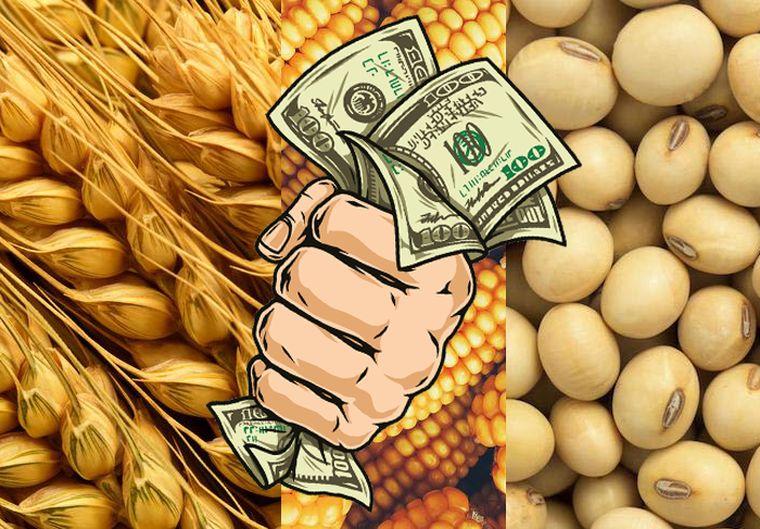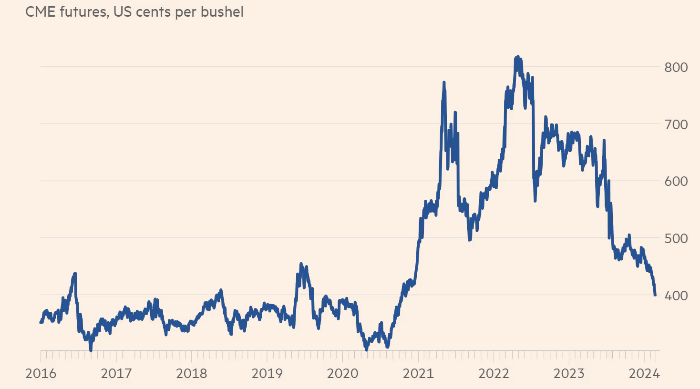Grain and oilseed prices are in a kind of downward race


Corn prices have been falling since 2022. Source: The Financial Times
Hedge funds and other speculators have accumulated a net short position of 546,000 futures contracts in all three crops – the largest negative bet in nearly 20 years, according to the latest data from the U.S. Commodity Futures Trading Commission. The rate increased as prices fell due to increased production in major agricultural countries, including Brazil, Russia and the United States.
Corn futures on the Chicago Mercantile Exchange fell to $4.22 per bushel, and wheat futures below $5.72, which is about 50% below the highs reached in May 2022. Soybean futures were down to $11.46 per bushel, compared to more than $17 earlier in the month.
“Such a prolonged negative trend attracts sellers,” said Ole Hansen, head of commodity strategy at Saxo Bank. “As long as the market remains in a downtrend, short positions will be maintained and potentially even strengthened,” he added.
The current price drop is in stark contrast to 2022, when corn, wheat and soybean prices soared after Russia launched its attack on Ukraine, two of the world’s largest grain exporters. This triggered a hunger crisis in poor regions of the world and raised the cost of food for consumers in rich countries.
However, high prices have encouraged farmers to increase their acreage. Brazil had a record harvest of corn and soybeans last year, and Russia exported a record amount of wheat. Ukraine also managed to sell a significant portion of its harvest on international markets.
“Grain and oilseed prices are in a kind of race to the bottom…as exporters dig themselves out of huge harvests,” said Michael Magdowitz, senior commodities analyst at Rabobank, adding that this will eventually lead to lower prices on supermarket shelves.
While hedge funds are increasing their bets on falling prices, commercial players who buy physical grain, not just futures, have increased their net long positions. This means they are waiting for prices to rise.
Farmers usually take a short position in the futures market because they lock in prices for future harvests to hedge the risk of falling prices. Now they are holding on to grain and betting on rising prices, “because prices are absolutely disgusting, and no one is selling anything, and if no one is selling anything, no one is planting anything,” Magdovits said.
This shortage of crops will likely lead to a price recovery, he added, noting that in the past, a net long position among food producers has always preceded a rally.
U.S. farmers have cut corn acreage by 4% and wheat by 5% compared to last year, according to the latest data from the U.S. Department of Agriculture. Less predictable weather due to climate change as well as geopolitics mean that current trends could change quickly, analysts say.
The huge speculative bets in these markets mean that when “a rebound does happen, it could be bigger than the fundamentals justify,” Hansen said. Hedge funds “will maintain a short position until the technical or fundamental picture tells them not to, and that effectively leaves the market open to a phenomenal short squeeze,” he added.
Read also
Wheat in Southern Brazil Impacted by Dry Weather and Frosts
Oilseed Industry. Leaders and Strategies in the Times of a Great Change
Black Sea & Danube Region: Oilseed and Vegoil Markets Within Ongoing Transfor...
Serbia. The drought will cause extremely high losses for farmers this year
2023/24 Safrinha Corn in Brazil 91% Harvested
Write to us
Our manager will contact you soon



